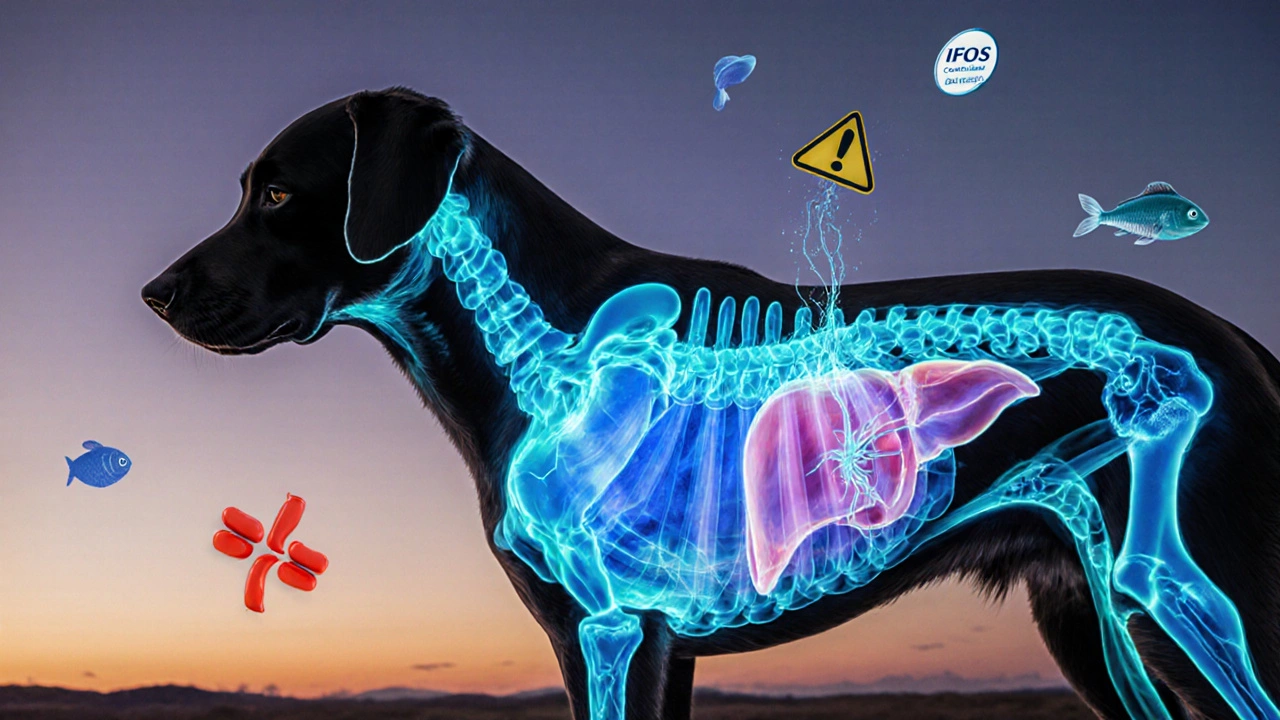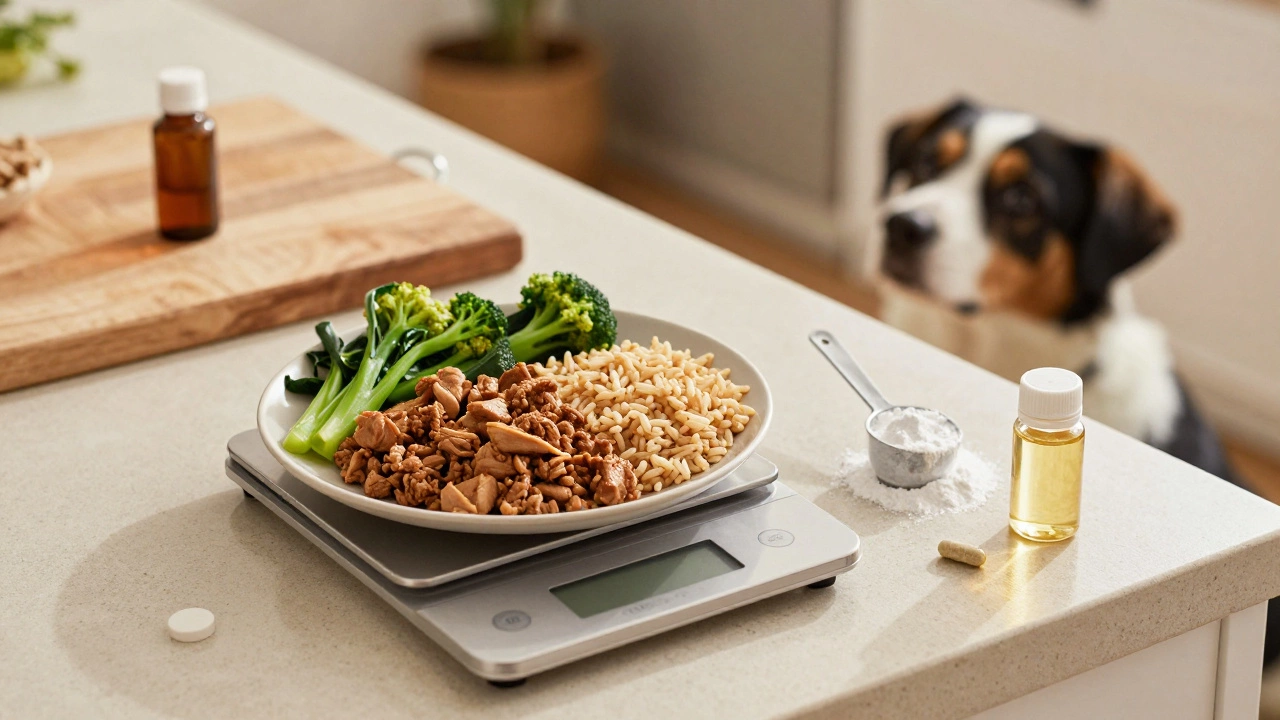Every dog owner wants their pet to live a long, healthy life. You’ve probably seen fish oil bottles in the pet aisle, read about it online, or heard other dog owners swear by it. But here’s the real question: should I give my dog fish oil? It’s not just a trend. Fish oil can help - but only if you know how, when, and how much to use.
What Fish Oil Actually Does for Dogs
Fish oil is packed with omega-3 fatty acids, mainly EPA and DHA. These aren’t just fancy words - they’re the active ingredients that make a difference. EPA helps reduce inflammation. DHA supports brain and eye health. Together, they work like a natural anti-inflammatory for dogs with arthritis, itchy skin, or even heart issues.
A 2021 study in the Journal of Veterinary Internal Medicine showed dogs with osteoarthritis moved more easily after 8 weeks of daily fish oil. Their owners reported less stiffness and better mobility. That’s not magic. That’s science.
It’s not just for older dogs, either. Puppies benefit from DHA for brain development. Dogs with allergies often see less scratching and red skin. Even dogs with kidney disease can get support - omega-3s help slow inflammation that damages organs over time.
How Fish Oil Compares to Other Supplements
There are lots of dog supplements out there. Glucosamine for joints. Probiotics for digestion. Coconut oil for shiny coats. But fish oil is one of the few with strong, repeated evidence across multiple health areas.
Here’s how it stacks up:
| Supplement | Best For | Time to See Results | Side Effects |
|---|---|---|---|
| Fish Oil (EPA/DHA) | Inflammation, skin, joints, heart, brain | 4-8 weeks | Mild diarrhea, fishy breath |
| Glucosamine | Joint cartilage repair | 8-12 weeks | Upset stomach, rare allergies |
| Probiotics | Digestion, diarrhea, gut balance | 1-2 weeks | Bloating, gas |
| Coconut Oil | Coat shine, minor skin issues | 2-4 weeks | Weight gain, loose stools |
Fish oil hits more targets than most. It doesn’t just treat one problem - it supports whole-body health. That’s why vets often recommend it as a baseline supplement, even for healthy dogs.
How Much Fish Oil Is Too Much?
This is where most owners go wrong. Giving too much fish oil can backfire. Too much omega-3 can thin the blood, interfere with healing, or cause vomiting and diarrhea.
The general rule from the Association of American Feed Control Officials (AAFCO) and veterinary nutritionists: 100 mg of combined EPA and DHA per 10 pounds of body weight daily.
So:
- A 20-pound dog: 200 mg EPA+DHA per day
- A 50-pound dog: 500 mg EPA+DHA per day
- A 90-pound dog: 900 mg EPA+DHA per day
Check the label. Many fish oil bottles list total fish oil content - not EPA and DHA. You need the actual omega-3 numbers. A capsule might say “1,000 mg fish oil” but only contain 300 mg EPA+DHA. That’s fine - just calculate based on the active ingredients.
Start low. Give half the dose for the first week. Watch for loose stools. If your dog handles it well, bump up to the full amount. Never exceed 300 mg EPA+DHA per 10 pounds without talking to your vet.

When Not to Give Fish Oil
Fish oil isn’t safe for every dog. Avoid it if your dog:
- Has a bleeding disorder or is on blood thinners like aspirin or clopidogrel
- Has pancreatitis - high fat content can trigger flare-ups
- Is allergic to fish or shellfish
- Has liver disease - omega-3s are processed by the liver
Also, don’t use fish oil if your dog is about to have surgery. Omega-3s can increase bleeding risk. Stop giving it at least 10 days before any procedure.
And please - don’t use human fish oil capsules unless you’re sure of the dosage. Human formulas often have higher doses or added vitamins (like vitamin A) that can be toxic to dogs in large amounts.
What Kind of Fish Oil Should You Buy?
Not all fish oil is created equal. Cheap brands might use low-quality fish, add fillers, or let the oil go rancid. Rancid fish oil doesn’t help - it harms.
Look for these signs of quality:
- Third-party testing (look for IFOS or GOED certification on the label)
- Clear expiration date and batch number
- Stored in dark bottles (light breaks down omega-3s)
- Smells fresh - not fishy or sour
Trusted brands like Nordic Naturals, VetriScience, and Grizzly Salmon Oil are commonly recommended by vets. Liquid forms are easier to dose, but soft chews are great for picky eaters.
Some owners try flaxseed oil thinking it’s a plant-based alternative. It’s not. Dogs can’t convert ALA (the omega-3 in flax) into EPA and DHA efficiently. You’d need to give 10 times the amount - and even then, it won’t work like fish oil.
How to Give It to Your Dog
Most dogs don’t mind the taste if you mix it right. Try:
- Drizzling liquid over kibble
- Mixing into wet food or homemade meals
- Using soft chews if your dog won’t eat it in liquid form
- Freezing small portions in ice cube trays for hot days
Don’t give it on an empty stomach - it can cause nausea. Always give with food.
If your dog gags or refuses it, try a different brand. Some use purified, odorless formulas. Others add chicken or salmon flavor to mask the fish taste.

How Long Until You See Results?
Patience matters. Omega-3s build up slowly in the body. You won’t see changes overnight.
- Itchy skin: 4-6 weeks
- Joint mobility: 6-8 weeks
- Coat shine: 3-4 weeks
- Brain focus in puppies: 8-12 weeks
Keep a journal. Note changes in energy, scratching, stiffness, or even behavior. Sometimes the improvements are subtle - your dog just seems happier, more playful, or less stiff in the morning.
When to Talk to Your Vet
Always check with your vet before starting any supplement. They know your dog’s history, current meds, and health risks.
Call your vet if:
- Your dog has diarrhea for more than 3 days
- Your dog loses appetite or seems lethargic
- You’re unsure about the right dose
- Your dog has a chronic illness like kidney or liver disease
Some vets will even run blood tests to check omega-3 levels - especially for dogs with serious conditions like heart disease or allergies.
Final Answer: Should You Give Your Dog Fish Oil?
Yes - if you do it right.
Fish oil is one of the most effective, well-researched supplements for dogs. It helps with inflammation, skin, joints, heart, and brain health. But it’s not a cure-all. It’s a supportive tool. Used correctly, it can improve your dog’s quality of life. Used wrong, it can cause problems.
Start with a vet-approved dose. Choose a quality product. Watch for side effects. Give it time. And don’t expect miracles - just steady, lasting improvements.
If your dog has aches, itchy skin, or just seems a little sluggish, fish oil might be the quiet upgrade they’ve been missing.
Can I give my dog human fish oil pills?
You can, but it’s risky. Human fish oil often has higher doses of EPA and DHA than dogs need. Some also contain vitamin A or D, which can be toxic in large amounts. If you use human pills, check the label carefully and calculate the exact EPA+DHA amount based on your dog’s weight. It’s safer to use a product made for dogs.
How long does fish oil last once opened?
Most fish oil lasts 3-6 months after opening if stored in the fridge. Check the expiration date and smell it. If it smells sour or rancid, throw it out. Rancid oil loses its benefits and can harm your dog’s digestion.
Will fish oil make my dog smell fishy?
Sometimes. Your dog’s breath or coat might have a mild fishy odor, especially at first. This usually fades. If the smell is strong or your dog’s skin smells bad, it could mean the oil is rancid or your dog has a skin infection. Talk to your vet if the smell persists.
Can fish oil help with dog allergies?
Yes. Omega-3s reduce inflammation in the skin, which can lessen itching and redness from environmental or food allergies. It won’t cure allergies, but many owners report fewer flare-ups and less need for antihistamines or steroids when fish oil is part of the routine.
Is liquid fish oil better than chews?
Liquid gives you more control over the dose and usually has fewer additives. Chews are easier for picky dogs but often contain extra sugars, binders, or artificial flavors. If your dog eats it without fuss, chews are fine. If you want purity and precision, go with liquid.








